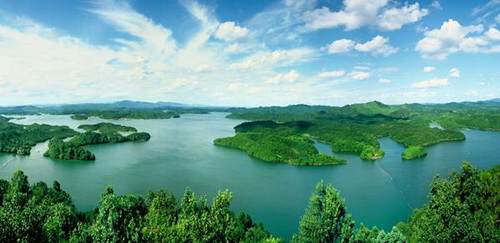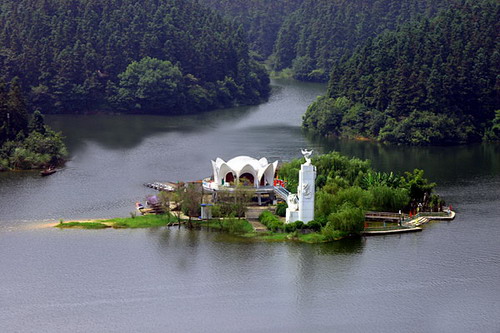Lofty Lushan Mountain
Temples in Hidden Places
On the First of August
Wheels by the Water
Share your travel story with regional@chinadaily.com.cn
Fairy Lake
( chinadaily.com.cn )
Updated: 2011-09-20
 |
|
Fairy Lake is Asia's largest gene pool for subtropical varieties of trees. |
Fairy lake is located 16 kilometers southwest of the suburb of Xinyu city, Jiangxi province. It is a famous lake-type national scenic area and Asia's largest gene pool for subtropical varieties of trees.
Out of the 198 square kilometer scenic area, 50 square km is consumed by the lake. The Subtropical Forestry Test Center of the Chinese Academy of Forestry is located 30 kilometers southwest of the lake in Dagang Mountain scenic spot. At the foot of Xiaobei Hill in the north shore of the lake there is an arboretum, boasting a collection of 3,000 plant species, almost all tree species available in Southern China.
There are also famous for its splendid historical and cultural heritage, with more than 300 ancient cultural sites, ancient tombs, ancient buildings, ancient stone carvings, former revolutionary sites, and display of specimen collections from nearly ten thousand pieces of cultural relics. Two sites dating back to Paleolithic period 200 thousand years ago, 10 neolithic sites, around 70 Shang and Zhou dynasties sites, and six sites from the Spring and Autumn Period have been discovered.
 |
|
The island where the handsome young man met with the fairies. |
Archaeological excavations indicate that the ancestors of Xinyu resided here as early as 200,000 years ago.
Anecdotes about Spirits and Immortals, the mystery story series from the Eastern Jin Dynasty (AD 317-420), recorded such a story: a long time ago, six or seven bird fairies in feather clothes were looking for their dreamed paradise. When they flew over Fairy Lake, they were immediately drawn to the scenery and transformed into beautiful maids upon landing. Then they took off the feather clothes and a handsome young man caught sight of them. He was instantly attracted.
He quietly hid one of their feather suits and then went over to them fervor. Upon seeing him, the fairies quickly put on feather clothes and rose to the sky. Yet the one without the feather suit could not fly away. When she realized she was in a hopeless situation she also noticed the handsome boy – it was love at first sight. Afterwards they formed enchanted ties.
Lu Zhao, the first Zhuangyuan (title conferred to the scholar who came first in the highest imperial examination in ancient times) of Jiangxi province, was from Xinyu. He was eager to learn as a child and later became Zhuangyuan and held offices at royal and local courts. Today, in the Fairy Lake scenic area people will see a study desk once used by Lu Zhao.
Zhuangyuan of Jiangxi around the Fairy Lake produced numerous poets, scholars and skilled craftsmen. Maestro Fu Baoshi (1904-1965) repeatedly set new records at international auction markets for his paintings that were greatly influenced by the cultural atmosphere of the lake.
Xinyu people have always attached importance to the technological development of the agriculture and handicraft industry with particular focus on iron and steel smelting. Guishan Hill and the Phoenix Hill are well known mining and metallurgy sites. Exploitation of the Works of Nature, which is an integrated work on agriculture and handicrafts, and one of the most important works on science and technology in the history of China, was written in the land of the Fairy Lake by Song Yingxing (1587-1661) in the Ming Dynasty.
 |
| The surface of the lake shimmers. |




